Kelp and seaweed are terms commonly interchanged, but they refer to different types of marine algae that share many similarities in their habitats, biological characteristics, and roles within the marine ecosystem. While both are important sources of nutrients and shelter in their respective underwater environments, they distinguish themselves in taxonomy and physical structure. Kelp is a type of large brown algae that belongs to the order Laminariales and is known for its long, tree-like structures with leaf-like blades, whereas seaweed is a more colloquial term that encompasses various species of macroscopic, multicellular, marine algae including red, green, and brown varieties.
Both kelp and seaweed are integral to their marine habitats, often forming underwater forests or beds that serve as vital havens for marine life, providing food and shelter. These underwater growths also contribute to coastal protection by buffering wave action and can influence local climates. In addition to their environmental role, kelp and seaweed have significant economic impact through their use in food products, cosmetics, and even as sustainable packaging materials. Recognizing the similarities between kelp and seaweed helps us understand the importance of preserving these ecosystems, not only for the health of the oceans but also for the benefits they provide to humans.

Key Takeaways
- Both kelp and seaweed are types of marine algae with key roles in their ecosystems.
- They are similar in environmental importance and human economic impact.
- Kelp and seaweed differ in taxonomy and physical structure despite their commonalities.
Defining Kelp and Seaweed
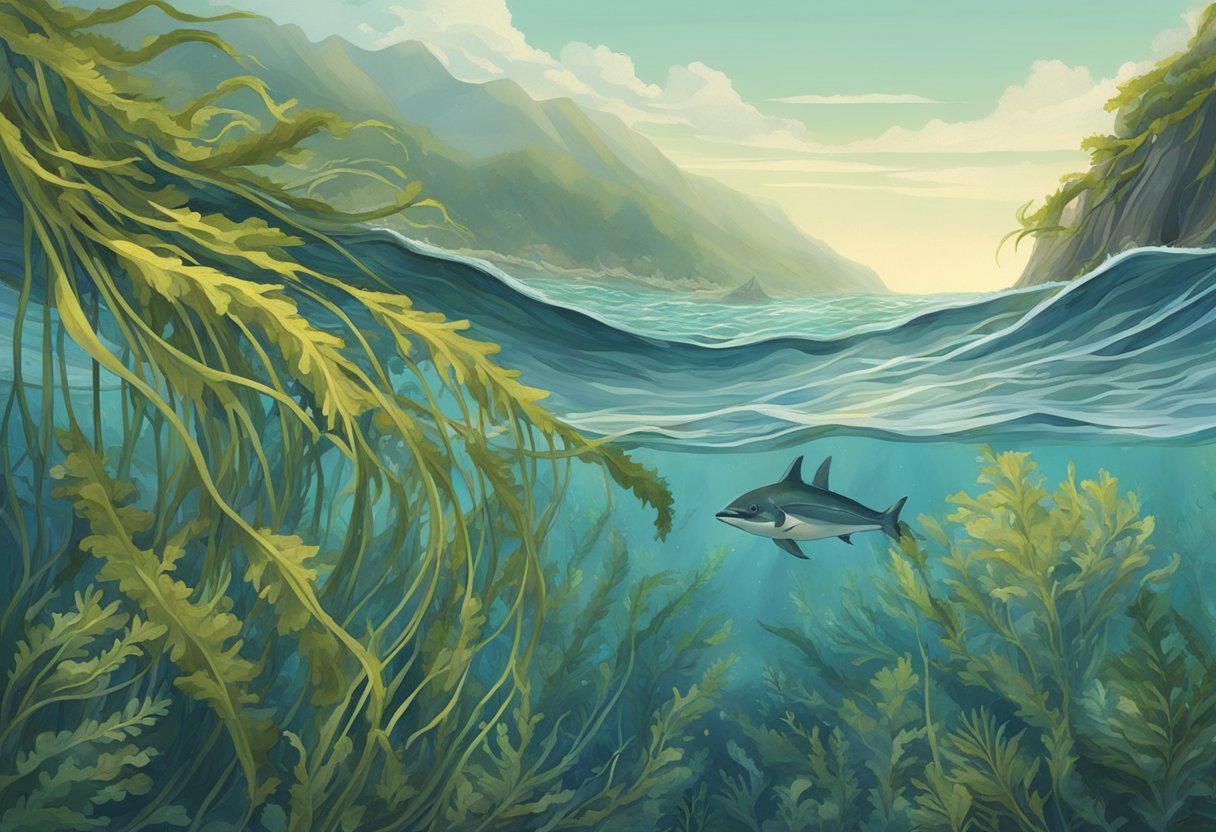
Kelp and seaweed are both important components of marine ecosystems, sharing characteristics that allow them to thrive in similar environments. Each possesses distinct features that warrant a focused examination.
Characteristics of Kelp
Kelp refers to large brown algae belonging to the order Laminariales. They are notable for their complex structure, featuring a holdfast that anchors them to the ocean floor, a stipe that resembles a stem, and leaf-like blades. Unique to kelp is their rapid growth rate and the formation of dense underwater forests that provide habitat for marine life. Kelp thrives in nutrient-rich, cold waters, predominantly along rocky coastlines.
- Environment: Cold, nutrient-rich waters
- Growth: Up to 18 inches (45 cm) per day
- Habitat: Forms underwater forests
-
Structure:
- Holdfast: Root-like anchoring structure
- Stipe: Stem-like column
- Blades: Leaf-like extensions
Characteristics of Seaweed
Seaweed is an inclusive term that encompasses many species of marine algae, including green, red, and brown varieties. Unlike kelp, seaweed describes a broader group and can vary greatly in size, from microscopic to several meters in length. Seaweeds do not always form the distinct forest structures like kelp, but they similarly serve as vital sources of shelter and food for marine organisms. Seaweed can inhabit a range of aquatic environments, from the intertidal zone to deep under the sea.
- Variety: Green, red, and brown algae
- Size: Microscopic to several meters
- Role: Provides shelter and nutrition to marine life
- Habitat: Diverse, from tidal pools to deep seascapes
Kelp and seaweed share similarities in their ecological roles and environments despite their structural differences. Both are key producers in their ecosystems and share a critical role in sustaining marine biodiversity.
Habitats and Growth Environment
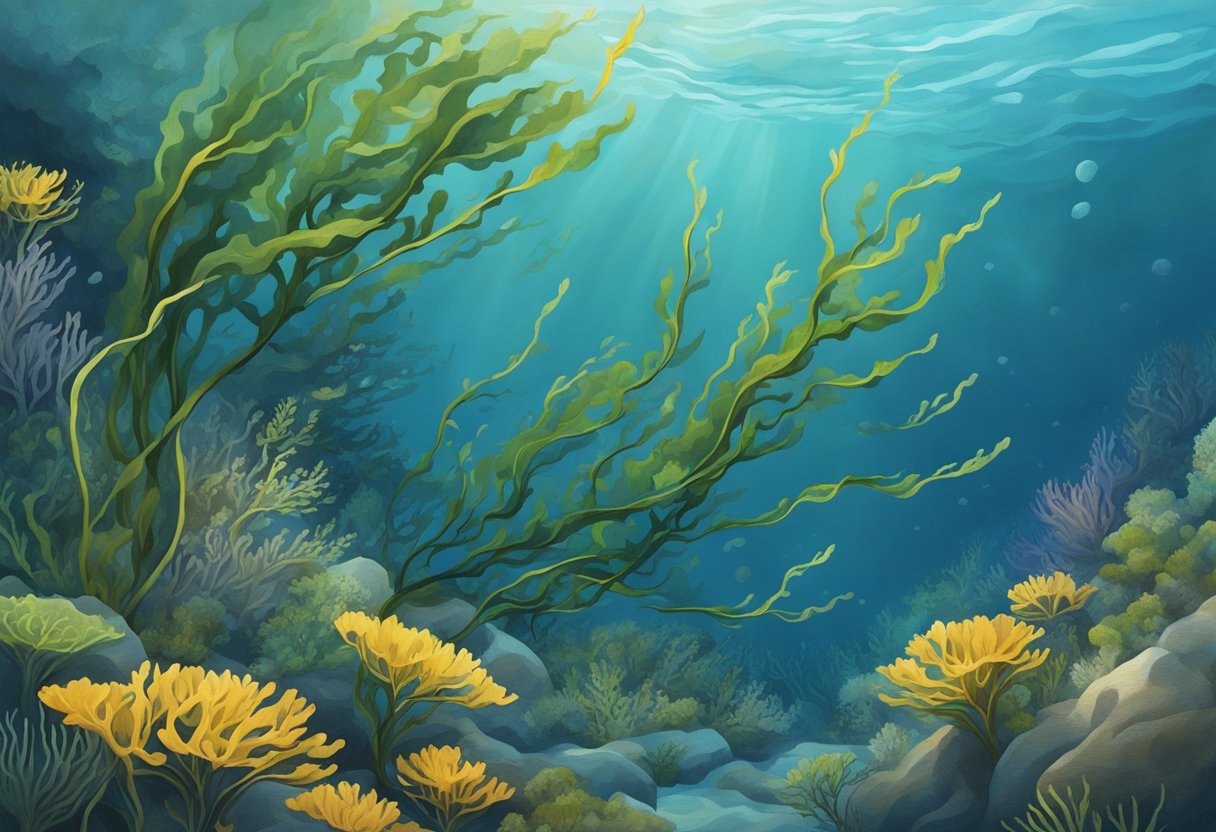
Both kelp and seaweed share marine habitats, thriving in nutrient-rich waters that support their growth and proliferation.
Kelp Forests
Kelp forests are underwater areas with a high density of kelp, which are large brown algae. These forests flourish in clear, cool, shallow ocean waters, often extending along coastlines in the Pacific Ocean, particularly on the western coasts of continents. Kelp grows on rocky substrates, to which they anchor themselves using root-like structures called holdfasts. Optimal growth conditions for kelp include:
- Light: Ample sunlight for photosynthesis
- Temperature: 43 to 57°F (6 to 14°C)
- Nutrients: High in nitrate and phosphate
- Substrate: Hard, rocky sea floors
Seaweed Growth Regions
Seaweed, which includes numerous species of marine algae, grows in diverse environments ranging from intertidal zones to deep sea waters. Unlike kelp, some seaweeds can also thrive in warmer waters and do not always require a firm substrate for anchoring. They are broadly distributed globally, from polar to tropical regions, adapting to a variety of conditions. The growth regions for seaweed can be characterized by:
- Light: Availability of sunlight varies with some species adapted to low light
- Temperature: Wider range than kelp, some species tolerate up to 84°F (29°C)
- Nutrients: Various depending on species
- Substrate: Ranging from rocky surfaces to floating or other soft substrates
Biological Similarities
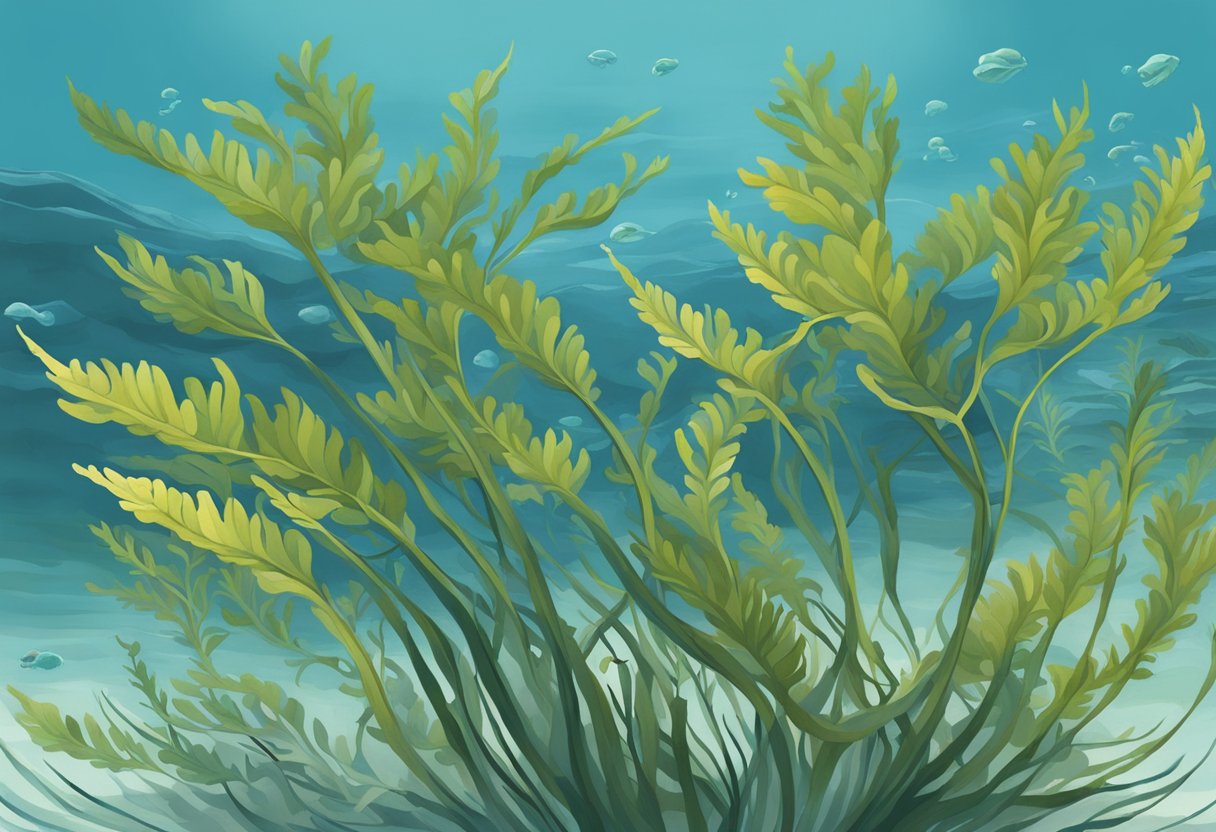
Kelp and seaweed share fundamental characteristics in their biological makeup, exhibiting similar cellular structures and photosynthetic processes, which allow them to thrive in marine environments.
Cellular Structure
Kelp and seaweed have eukaryotic cells, which contain a nucleus and other specialized structures called organelles. Their cell walls are primarily composed of cellulose, providing structural support and protection. Kelp, larger and typically more complex, belongs to the brown algae group, while seaweed encompasses multiple species across the green, red, and brown algae classifications.
Photosynthesis Process
The process of photosynthesis is another biological similarity between kelp and seaweed. They both possess chloroplasts, the organelles that enable the conversion of sunlight into energy. However, they differ slightly in their pigments; kelp utilizes fucoxanthin, giving it a brownish color, while seaweed may use various pigments leading to its green, red, or brown hues. Both organisms use sunlight to create organic materials, which serve as the foundation for the ocean's food web.
-
Key Photosynthetic Equation:
6CO2 + 6H2O + (energy from sunlight) → C6H12O6 + 6O2
-
Primary Photosynthetic Product: Glucose, an energy source for marine life.
Ecological Roles
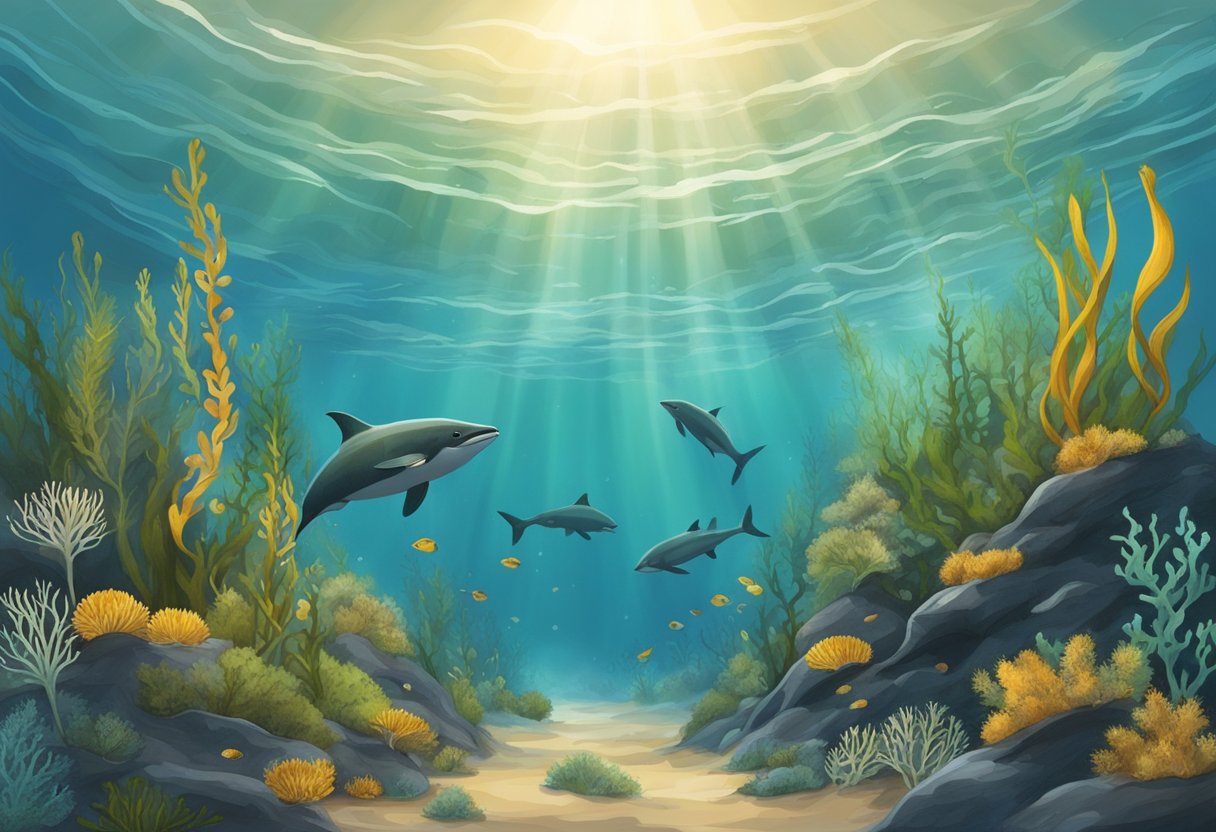
Kelp and seaweed hold pivotal positions within their marine ecosystems. Their ecological roles are substantial, supporting a wide array of marine life and maintaining environmental balance.
Importance to Marine Life
Kelp forests and seaweed beds provide crucial habitats for numerous marine organisms. They offer shelter and nursery grounds for fish, invertebrates, and marine mammals. As a primary producer, kelp and seaweed are also a significant food source. Diverse species, including urchins and abalone, rely on them for sustenance.
Role in Oceanic Ecosystems
In oceanic ecosystems, kelp and seaweed are vital in nutrient cycling and contribute to carbon sequestration. They absorb carbon dioxide during photosynthesis, which helps to regulate atmospheric CO2 levels. Moreover, their ability to create structured habitats facilitates biodiversity, forming the foundation of complex food webs.
Human Uses and Economic Impact
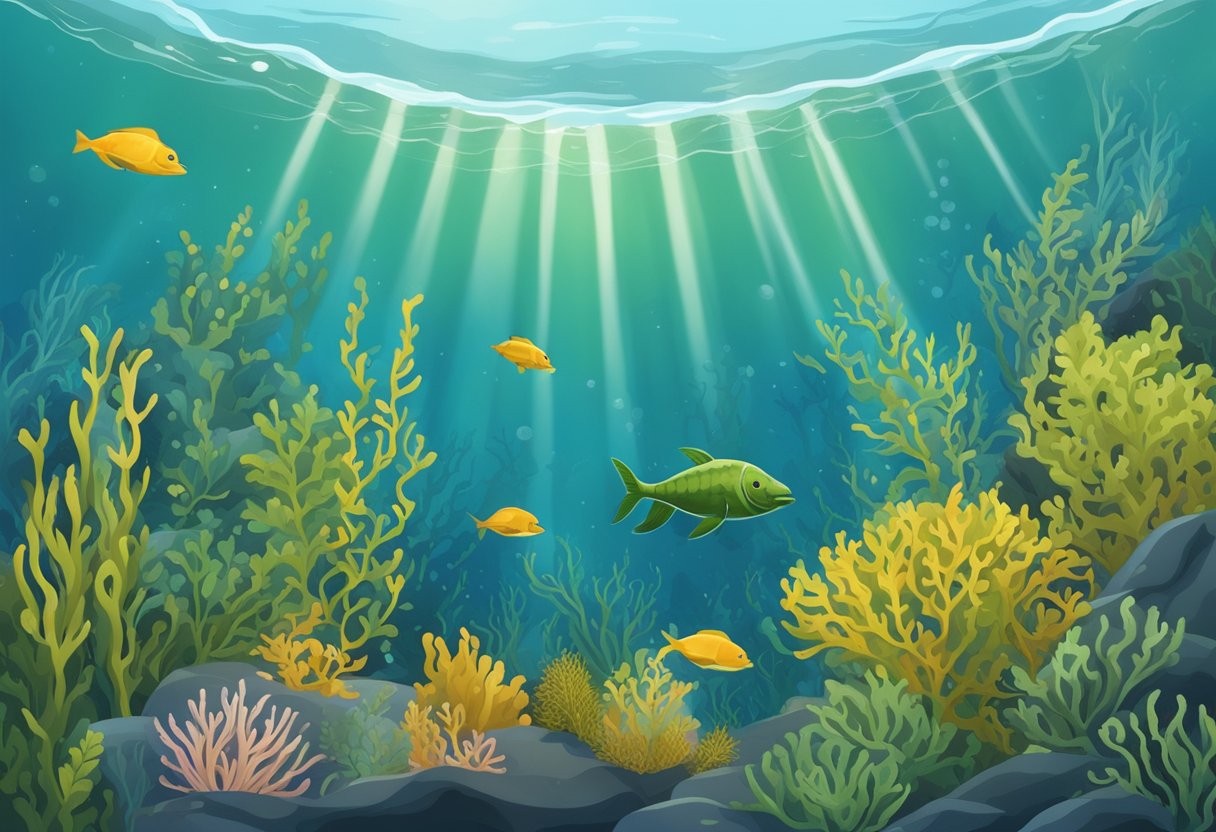
Kelp and seaweed have become integral components within various industries due to their unique characteristics and abundance. They are increasingly recognized for their versatility and sustainability, contributing positively to economic growth and human nutrition.
Food Industry Usage
Kelp and seaweed are widely used in the food industry for their nutritional benefits and flavoring properties. They are featured in:
- Asian cuisines: As a staple ingredient in dishes such as sushi, soups, and salads.
- Health foods: Valued for their high content of vitamins, minerals, and dietary fiber.
- Food additives: Providing thickeners and stabilizers like alginate, carrageenan, and agar.
Table 1: Nutritional Components in Kelp and Seaweed
| Nutrient | Benefit |
|---|---|
| Iodine | Supports thyroid function |
| Vitamin K | Aids in blood clotting |
| Calcium | Essential for bone health |
| Iron | Crucial for oxygen transport |
Other Commercial Applications
Beyond the food sector, both kelp and seaweed have diverse commercial applications:
- Agriculture: Used as biofertilizers to enhance soil quality and crop yield.
- Cosmetics: Ingredients in skincare products for hydrating and anti-aging properties.
- Biofuel production: Investigated as a renewable source of energy.
- Pharmaceuticals: Exploited for their potential in drug development and health supplements.
List of Commercial Applications
- Biofertilizers
- Skin care products
- Renewable energy sources
- Health supplements
Their role in these sectors illustrates their significance and holds the promise of future economic impact as their uses expand.
Frequently Asked Questions
Discover key insights into how kelp and other types of seaweed share nutritional benefits, environmental roles, and culinary uses.
What are the nutritional similarities between kelp and other types of seaweed?
Kelp and other seaweed forms are rich in vitamins, particularly A, C, E, and K, and contain essential minerals like iodine, calcium, and magnesium. They both offer abundant dietary fiber and a proper balance of omega-3 and omega-6 fatty acids.
What are the common benefits of consuming both kelp and seaweed?
Consuming kelp and seaweed can support thyroid function due to their high iodine content, contribute to cardiovascular health, and promote healthy digestion. Both are also celebrated for their antioxidant properties that help protect cells from oxidative stress.
In what ways do the physical characteristics of kelp overlap with those of other seaweeds?
Kelp and other seaweeds share a similar basic structure, with a holdfast that anchors them to the ocean floor, a stipe which is analogous to a stem, and leaf-like blades. They exhibit a range of colors from deep greens to browns, attributed to their chlorophyll and other pigments allowing for photosynthesis.
How do kelp and other seaweed varieties compare in terms of their ecological roles?
Both kelp and various seaweeds serve as important habitats for marine life, offering shelter and food. They also play a crucial role in their ecosystems as primary producers and are involved in nutrient cycling, maintaining water quality by absorbing excess nutrients and carbon dioxide.
Can the taste profile of kelp be distinguished from that of other seaweed species?
Kelp often has a more pronounced umami flavor compared to other seaweeds, which can range from sweet to briny. The taste variations are due to differences in species, environment, and preparation methods, yet they all share a characteristic marine savoriness.
Are there any notable similarities in the way kelp and other seaweeds are used in culinary applications?
Kelp and other seaweeds are used similarly in cooking, often as flavor enhancers in broths and seasonings. They are also commonly found in dried forms, rehydrated for use in salads, soups, and sushi. Their versatility is celebrated in various traditional and modern cuisines across the world.




